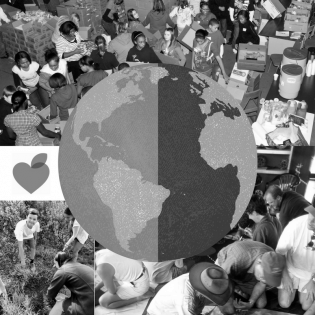The Whole World in Our Hands (Private-Religious)
This lesson will introduce the concept of tikkun olam and teach of its importance. It will show youth that everyone has the ability to do tikkun olam, and that it can be accomplished in a variety of ways.
The learner will:
- demonstrate an understanding of the pasuk in Tosefta Berakhot 4:1 "One should only use one’s face, hands, and feet to honor one’s creator."
- identify ways different skills can be used to help others.
- demonstrate an understanding of the concept of tikkun olam.
- Poster with pictures from magazine of people doing a variety of activities.
- Book - Mitzvah Magic (see Bibliography)
Youth may look for opportunities to helpful at home.
Siegel, Danny. Mitzvah Magic: What Kids Can Do to Change the World (Kar-Ben Publishing)
Instructions
Anticipatory Set:
Ask the children to name an interest, skill, or talent they possess (playing an instrument, drawing, playing sports). Write their responses on the board. Say, "Everyone has time, talent and treasure that they can give. Giving those things to make the world a better place is called philanthropy."
Write the following pasuk on the board: "One should only use one’s face, hands, and feet to honor one’s creator." (Tosefta Berakhot 4:1)
- Discuss what this pasuk means. The final main point to bring up is that God gave each of us certain talents. We should use these talents for good—to help others. Since God wants us to help others, doing so will bring honor to God. Everyone can be a philanthropist.
Go through the list on the board of the children's interests/talents. Together come up with ways each interest/talent can be used to help others. Examples:
- Play the violin – Play the violin for people in the hospital to cheer them up.
- Baking – Bake cookies and bring them to someone who is homebound, or organize a bake sale to raise money for tzedakah.
- Sports – Play sports with a child with disabilities, or with someone you know who might be lonely. Teach someone to play a sport.
Read sections (or summarize content of sections) from Mitzvah Magic: What Kids Can Do to Change the World, by Danny Siegel. Mitzvah Magic tells the stories of young people who have organized projects to help others. Each chapter ends with suggestions of projects kids can do.
- Bring up the point that sometimes ideas for projects come from existing problems. People see specific problems in the world and want to help solve that problem. Mitzvah Magic contains examples of projects that began in this way.
- Explain that the people in the book are just ordinary people like them, who decided they wanted to help better the world. Introduce the phrase tikkun olam, which literally means, "repairing the world."
- Discuss what this means. How can one "repair" the world? Is the world broken?
Lead the class in brainstorming ways they, as a group, can help improve the world. Help them come up with a feasible plan, such as doing an art project with seniors, or delivering balloons to a children’s hospital ward. Alternatively, the teacher can decide on an activity that would be best suited for the class.
Philanthropy Framework
-
Strand PHIL.I Definitions of Philanthropy
-
Standard DP 01. Define Philanthropy
-
Benchmark E.1 Define philanthropy as the giving and sharing of time, talent, or treasure intended for the common good.
-
-
-
Strand PHIL.II Philanthropy and Civil Society
-
Standard PCS 02. Diverse Cultures
-
Benchmark E.4 Demonstrate listening skills.
-
-
Standard PCS 05. Philanthropy and Government
-
Benchmark E.9 Describe how philanthropic activities can bring about social change.
-
-
-
Strand PHIL.III Philanthropy and the Individual
-
Standard PI 01. Reasons for Individual Philanthropy
-
Benchmark E.1 Describe one reason why a person might give or volunteer.
-
Benchmark E.5 Give examples of actions students can take to improve the common good and list or describe responsibilities that go with those actions.
-
-
